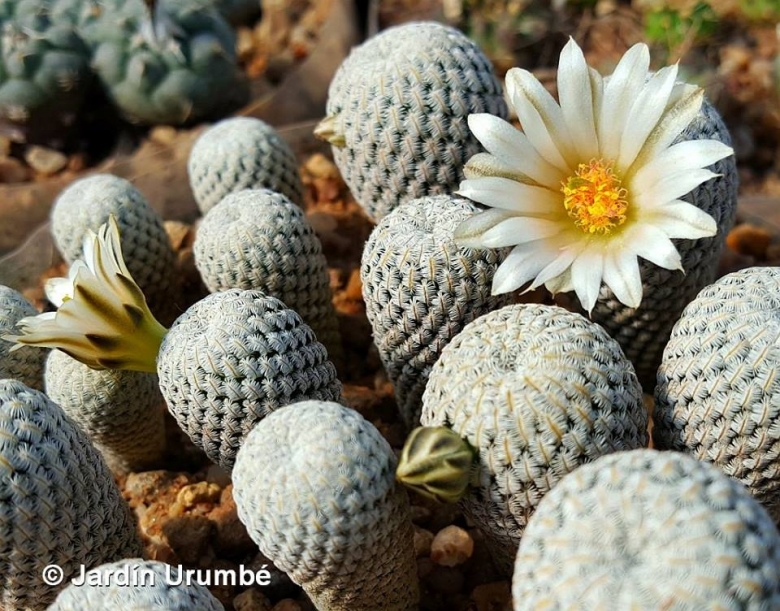Accepted Scientific Name: Mammillaria pectinifera F.A.C.Weber in Bois
Dict. Hort. [Bois] 2: 804. 1898 Bois cf. Britton & Rose. Cactaceae. 4: 64 (1923)

Mammillaria pectinifera f. albiflora Photo by: Alexander Arzberger
Origin and Habitat: Unknown, probably horticultural, but its ancestor is most likely from Puebla, Mexico).
Synonyms:
See all synonyms of Mammillaria pectinifera
back
Accepted name in llifle Database:Mammillaria pectinifera F.A.C.Weber in BoisDict. Hort. [Bois] 2: 804. 1898Synonymy: 13
back
Description: Mammillaria pectinifera f. albifloraSN|1537]]SN|34353]] is a flower variant of Mammillaria pectiniferaSN|1537]]SN|1537]] distinguished from the latter by the pure white blooms. The differences with other M. pectinifera are in reality very minimal and the two plants are not readily distinguishable, if not flowering.
For more details see: Mammillaria pectiniferaSN|34353]]SN|1537]]
Subspecies, varieties, forms and cultivars of plants belonging to the Mammillaria pectinifera group
 Mammillaria pectinifera F.A.C.Weber in Bois: It is a small cactus that in habitat appears above the ground as a squat stem. Spines: 20-40, pectinate, flattened against the body, fine, numerous, white, 1.5 - 2 mm long. Lacking central spines. Distribution: Puebla.
Mammillaria pectinifera F.A.C.Weber in Bois: It is a small cactus that in habitat appears above the ground as a squat stem. Spines: 20-40, pectinate, flattened against the body, fine, numerous, white, 1.5 - 2 mm long. Lacking central spines. Distribution: Puebla. Mammillaria pectinifera f. albiflora hort.: has white flowers. Garden origin.
Mammillaria pectinifera f. albiflora hort.: has white flowers. Garden origin. Mammillaria pectinifera f. cristata hort.: crested form. This plant has different crested forms, some very thin and other wide and strong.
Mammillaria pectinifera f. cristata hort.: crested form. This plant has different crested forms, some very thin and other wide and strong. Mammillaria pectinifera f. monstruosa hort.: has apparentely spineless, creamy-white, extremely elongated areoles, but if you look carefully, they are formed by extremely, short bristle-like spines that give the areoles their characteristic felty appearance.
Mammillaria pectinifera f. monstruosa hort.: has apparentely spineless, creamy-white, extremely elongated areoles, but if you look carefully, they are formed by extremely, short bristle-like spines that give the areoles their characteristic felty appearance. Mammillaria solisioides Backeb.: has only 25, flexible, chalky or dirty white, less pectinately arranged than the type and flattened against the stem surface, to 5 mm long. Central spines: Not present. Distribution: Oaxaca and Puebla.
Mammillaria solisioides Backeb.: has only 25, flexible, chalky or dirty white, less pectinately arranged than the type and flattened against the stem surface, to 5 mm long. Central spines: Not present. Distribution: Oaxaca and Puebla.
Cultivation and Propagation: Slow growing, this plant is very rot prone and temperamental when cultivated on its own roots, but it is easy to grow if grafted.
Potting subtratum: This species has a fairly large tap root, and should be kept in a deep pot with a very draining mineral substrate.
Moisture: Water regularly during the active growing season (spring and summer), this will encourage steady growth. But be careful with watering, which all thick rooted species require (rot sensitive). Keep dry during the winter rest.
Feeding: Fertilize every 2 weeks with diluted high potassium fertilizer when the plant is in bud.
Exposition: Light shade or full sun exposures.
Traditional uses: Though sometimes called peyote, there is little evidence for the ceremonial use or psychoactive properties of the cactus.
Propagation: Direct sow after last frost. (seldom produces offsets)










